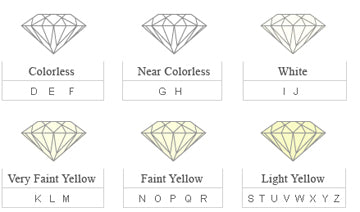When designing your custom piece of jewelry it is important to know what you're choosing, and why! Below contains basic information on stones, metals, settings, and different facts to help you choose what ring is best for you.
Karat= metal/gold content
Carat= diamond weight
Lab made diamonds: are man-made diamonds that are crafted in a lab. These diamonds are ethical, eco-friendly because of their creation process, and significantly cheaper than natural diamonds. Lab made diamonds are nearly the same as natural diamonds except their process of creation is different. A Lab grown diamond is made up of the exact same chemical composition as a diamond. Lab diamonds are classified as a real diamond, and test as real diamonds with a diamond tester.
Moissanite Diamonds:
A moissanite would be classified as a diamond simulant, also created in a lab through a different process with different compositions. Moissanite is chosen because it is cheaper than a natural or lab made diamond, it is eco friendly, and ethical, and the best part? It is more sparkly than a diamond with a rate of 2.65-2.69 of light refraction. The moissanite is not as hard as a diamond, but comes second in "hardness" according to the MOHS hardness scale.
Natural Diamonds:
Classic, timeless, and mined, natural diamonds have remained a favourite and are the most popular consumer choice. A diamond is a solid form of carbon, and it is mined. Natural diamonds can be expensive.
Compare Moissanite, Lab Grown Diamonds, and Natural Diamond properties:
| Diamond Element Properties | Moissanite | Lab Grown Diamond | Diamond |
| Mining | Mining Free | Mining Free | Mining |
| Eco-Friendly | Yes | Yes | No |
| Refractive Index | 2.65-2.96 | 2.42 | 2.42 |
| Hardness | 9.25 - 9.50 | 10 | 10 |
| Conflict Free (Is it eye clean?) | Yes | Yes | Depends on choice |
| Fire (Color Refraction) | 0.104 | 0.044 | 0.044 |
| Luster | 20.40% | 17.20% | 17.20% |
| Toughness | Excellent | Excellent | Excellent |
| Durability | Life Time | Life Time | Life Time |
| Ethical | Yes | Yes | Not usually |
|
Price |
$ | $$ | $$$$ |
(Diamondrensu, 2020)
Diamond Clarity Ratings and What They Mean:
There are so many big box jewelers and retailers that will sell you an expensive engagement ring with poor quality stones. Consumers are often taken advantage of because they do not have the proper knowledge regarding stone color and clarity. We like to think that this is something that sets us apart. It’s actually a passion of ours to help you understand what makes a stone beautiful, and what a high quality stone truly is. We will work with you to explain stone clarity; sourcing you the highest quality stones that fit best within your budget. We have seen and worked with flawless diamonds and they prove to us over and over again that clarity is INTEGRAL and IMPORTANT!
There are 8 different diamond clarity ratings, and these ratings help us to determine how "eye clean" a diamond is. The more inclusions- the more "salt and pepper" effect a diamond will have. Diamond clarity becomes increasingly more important as the size of the stone increases, the larger the stone- the easier it is to see inclusions. Inclusions often look like small black dots that can be incredibly small or large.
A friendly reminder that the more clear a diamond is, the more expensive it can be.

(Rare Carat, 2022)
Diamond Color Ratings and What They Mean:
The less colorful a diamond is, the more rare it is. Color can also impact how a diamond looks, it is important to invest in the stone you like because it will last a lifetime.

Metals- which metal setting is right for you?
Choosing the metal that is right for you is highly important, typically most people invest in pieces that are 14 karat gold for engagement pieces and wedding bands. For custom pieces, we offer 10k, 14k, and 18k white gold, rose gold, and gold. You might be thinking that since certain bands are less pure, they may be less durable, but this is not actually the case. The more alloying metal accompanying the piece of jewelry, the more durable it will be. Gold is known for being extremely soft and malleable, the more accompanying composite (alloying metals) the hardier the piece of jewelry will be.
The only downside to choosing gold that is less pure, is that the color will vary. The less pure the gold, the more pink-toned it will be.
10k- 41.667% pure gold, 58.33% alloying metals
14k- 58.33% pure gold, 41.67% alloying metals
18k- 75% pure gold, 25% alloying metals
24 karat gold is the most pure, and most expensive type of gold.
Platinum: has been an increasingly popular metal to set stones in. Platinum may be preferable as it is cheaper, and significantly stronger than gold.
Alternative Stones
Gemstones:
We can source any gemstones you’d like for your custom piece.
We recommend furthering your own research on gemstone hardness to determine whether or not your gemstone is durable enough for a wedding ring/engagement ring.